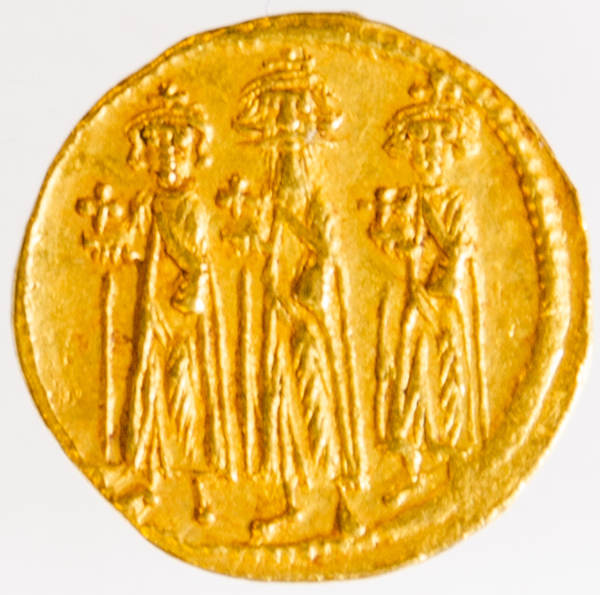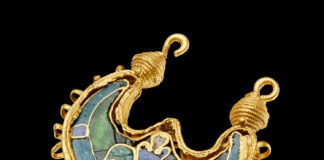
Princeton University Library’s Numismatic Collection nearly tripled its Byzantine coin collection when it acquired 11,256 Byzantine coins from the estate of Dr. Chris B. Theodotou on 8th March 2022. The acquisition adds to the 5,280 Byzantine coins of the Peter Donald collection, acquired in 2016. Both collections were acquired with support from the Friends of Princeton University Library, while the Seeger Center for Hellenic Studies provided half the funding for these two acquisitions. Together with previous holdings, Princeton now has the largest Byzantine coin collection in the world.
The coins, which are primarily issues of the Byzantine Empire between C.E. 500 and 1453, were collected by Theodotou between 1979 and 1987. According to Curator of Numismatics Alan Stahl, Theodotou was both a friend and collecting rival of Donald.
“It was, in fact, while the two men were going from one coin dealer to another in London in 1987 that Theodotou suffered a fatal heart attack,” said Stahl. The collection was then managed by Theodotou’s widow, Helen, until her death in 2013. “When the heirs read that Princeton had acquired the Donald Collection in 2016, they contacted us to see if we were interested in purchasing their collection as well,” said Stahl.
Though the Donald collection added considerable depth to the Library’s Numismatics holdings, it lacked any gold coins of the centuries before 1204, which Peter Donald had sold previously. Stahl noted that the Theodotou collection adds 350 gold coins, 305 silver coins, nearly 11,000 bronze coins, 300 lead seals, and 11 coin weights. “Both the Donald and the Theodotou collections were carefully compiled by individuals who sought examples of all known issues (as well as some hitherto unknown) and avoided duplication of common issues,” said Stahl. “With these two collections added to our previous holdings of Byzantine coins, we can now lay claim to having the largest and most representative collection of Byzantine coinage in the world. This will complement our strong faculty and other resources in Byzantine studies to confirm the University’s leadership in the teaching and research of this important field of history and culture.”
Conventional knowledge would suggest that gold is better than silver, but in the case of the Byzantine Empire, silver items are generally rarer. All of the new acquisitions, however, speak to preserving the empire’s culture, as few documents or examples of secular material culture remain since its disappearance. “The Byzantine court was famous for its highly codified system of display of rank through clothing, and the coins give us excellent sources for this study,” explained Stahl. “The inclusion of 300 personal lead seals in the Theodotou collection opens a whole new area for research at Princeton in the lives of individuals below the level of imperial office.”

According to Dr. Charlie Barber, Donald Drew Egbert Professor of Art & Archaeology, the Theodotou additions will create opportunities for new and diverse research projects. “Political and economic history have been granted a material ground from which to develop analyses,” Barber said. “Art historians can map the changing iconographies of power. Religious studies can contemplate the political play of the holy. We are truly fortunate to have a resource that can embrace the interests of so many and that can be put into conversation with communities and scholarly strengths already present at Princeton.”
Stahl mentioned the coins from Heraclius’ reign from 610 to 641 C.E. as notable examples of the stories the collection can tell. During his leadership, the Byzantine Empire was attacked by both the Sasanian Persians and the Arab. Adding to his status as a usurper of imperial power, these challenges created a need for him to spend much of his reign restoring legitimacy, a process which is detailed on the coins.
“A recent post-doctoral fellow at the Seeger Center for Hellenic Study came to the numismatic collection to examine in detail the presentation of Heraclius on his coinage for a book he was writing on the reign,” Stahl recalled. “Though we could show him examples from several periods in the reign, we lacked any gold solidus of the first few years as emperor, when he depicted himself alone in military garb; we now have three examples of this issue.”
“We value greatly our longstanding partnership with the Princeton University Library,” said Dimitri Gondicas, Stanley J. Seeger ’52 Director, Seeger Center for Hellenic Studies and Lecturer in the Council of the Humanities and Hellenic Studies. “Central to our mission is to build world-class Hellenic Collections and make them accessible to faculty, students, and visiting scholars. Our contribution towards the acquisition of the Theodotou Collection was made possible by the Stanley J. Seeger Hellenic Fund, in honor of the 40th anniversary of Hellenic Studies at Princeton.”
In keeping with PUL’s mission to facilitate world-class research, the Numismatic Collection has collaborated with the Seeger Center for Hellenic Studies to establish and jointly fund a term position for a scholar who will catalog the Donald and Theodotou collections and create a shared open access platform to display the Byzantine coins held by Princeton and other institutions.
Read more about Princeton’s acquisition of the Donald collection.
For further information about the Numismatic Collection of the Princeton University Library, visit their website.
Are you interested in Byzantine seals? Or not? Anyway, here you can learn something on Byzantine seals by baking your own cookies with Byzantine seal designs!
You can browse many Byzantine coins in the Dumbarton Oaks Online Collection.



